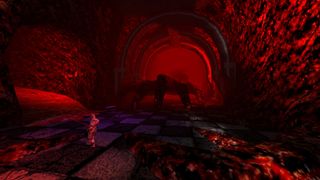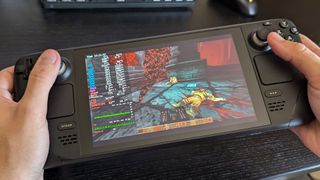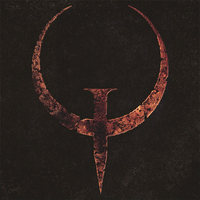This fan-made Quake level is bigger than the original FPS' chapters, with brutal difficulty that makes Dark Souls look like Peppa Pig
The Immortal Lock mod for Quake on PC features higher difficulties "intended to be impossible for the majority of players."

What you need to know
- The Immortal Lock is a user-made level compatible with the original 1996 first-person shooter Quake on PC.
- The mod requires a modern 64-bit port built from Quake's source code, vkQuake, to run.
- While Quake is 28 years old, The Immortal Lock requires modern hardware to run smoothly, and a solid-state drive (SSD) is strongly recommended for installation.
Despite DOOM getting most of the love from Bethesda Softworks and its Microsoft parents, I still love Quake after all these years. The 1996 classic was a game-changer for PC gamers, bringing first-person shooters into the third dimension with a new game engine that its developers would eventually outsource and revolutionize 3D gaming in general. One thing I never thought about Quake, however, was, "man, this game is too easy."
Well, too bad because an all-new playable level designed by modder Amelie C. Langlois, also known as ComfyByTheFire, delivers The Immortal Lock, a gigantic custom level for Quake. They promote the horror-themed segmented map as a story-driven experience with "extremely challenging fights" in what might go down as the understatement of the century because this thing is absolutely crushing, even with a scalable difficulty selection.
Quake (PC)
Grab the legendary follow-up to id Software's DOOM and jump into The Immortal Lock's slipgate today.
Disclaimer
The Immortal Lock is a custom map for Quake, not a standalone game. It requires the files from the full PC version and the latest 64-bit build of vkQuake, a source port of the original game that improves performance and allows higher framerates, resolutions, and dynamic lighting.
What is The Immortal Lock and how do I play it?

While The Immortal Lock utilizes the same weapons and enemy types from the original Quake files, the enormous interconnected level was created by seasoned modder ComfyByTheFire from scratch. The intention is to challenge even the most grizzled veterans who have mastered the classic FPS, filling its cosmic horror-laden halls with intricate platforming puzzles and hiding the necessary keys to unlock doors and progress forward.
Through the thin veil of reality, you find only a desolate plane of flesh and despair and a dread voice that beckons your name.
ComfyByTheFire
Players are gently encouraged to "play one difficulty lower than you normally would," which should be enough of a hint of its unforgiving combat and relentless pitfalls dotted around its avenues of cosmic horrors.
Quick-saves are your friends in The Immortal Lock, just as they were back in the late '90s before autosaves and regular cutscenes would save you from too much repetition. I spent a few hours getting acquainted with the surprising amount of interwoven story elements, mostly found as dropped notes from dead NPCs, and as a massive boomer shooter addict, I'm beyond hooked. Check out the trailer for a taste of its themes.
Installing The Immortal Lock on a Windows desktop or gaming laptop is about as simple as it gets. It doesn't require mod managers or a particular load order, only a legitimate copy of the game from Steam, GOG, or elsewhere. First, you need to install the original Quake and the vkQuake source port.
- Install Quake on your PC.
- Open the game's installation folder; you should see an 'id1' subfolder here.
- Download and unpack the latest x64 version of vkQuake from GitHub.
- Move all of the unpacked vkQuake files, including 'vkQuake.exe' to your open Quake installation folder and overwrite any prompted files.
You could open vkQuake.exe at this point to test how the original Quake runs on your hardware. While it's a retro classic, vkQuake does enhance the engine with dynamic shadows and other visual luxuries, so it's worth checking that your PC is comfortable running the base game first. Now, let's install The Immortal Lock.

- Download and unpack the latest version of The Immortal Lock from Slipseer.
- Move the unpacked 'immortal' to your open Quake installation folder.
- Launch vkQuake.exe and open the console with the tilde (~) key before typing 'game immortal' and pressing return.
- Click anywhere to show the main menu and start a new single-player game.
Alternatively, if the 'Mods' option appears in your main menu upon launching Quake, you should be able to select 'immortal' from there, and it achieves the same outcome. Congratulations, you're about to jump into the pits of a secret research facility in.. Finland. Enjoying the mod? Let me know in the comments.
Does it run on Steam Deck?

Yes, but it's far from perfect. While there is a native Linux port of vkQuake that handles Steam Deck controls without issue, the sheer enormity of The Immortal Lock causes some frame rate drops on Valve's handheld. Dropping the resolution to its bare minimum doesn't seem to affect the bad frame pacing in more demanding areas, but locking the maximum to 40 FPS can help with a smoother experience.
However, when you reach areas with a screen full of active projectiles (and there are plenty of those), you'll likely struggle to hit all your shots with perfect accuracy, as the mod demands. If you have a Windows-based ASUS ROG Ally, you might have a better experience, but it is at least 'playable' on the Steam Deck, at least by Valve's verification standards. I tested both the vkQuake-1.31.0.appImage for Linux and vkQuake-1.31.0 x64 binaries for Windows with Proton Experimental, and both performed about the same on Steam Deck.

Ben is the channel editor for all things tech-related at Windows Central. That includes PCs, the components inside, and any accessory you can connect to a Windows desktop or Xbox console. Not restricted to one platform, he also has a keen interest in Valve's Steam Deck handheld and the Linux-based operating system inside. Fueling this career with coffee since 2021, you can usually find him behind one screen or another. Find him on Mastodon @trzomb@mastodon.online to ask questions or share opinions.

